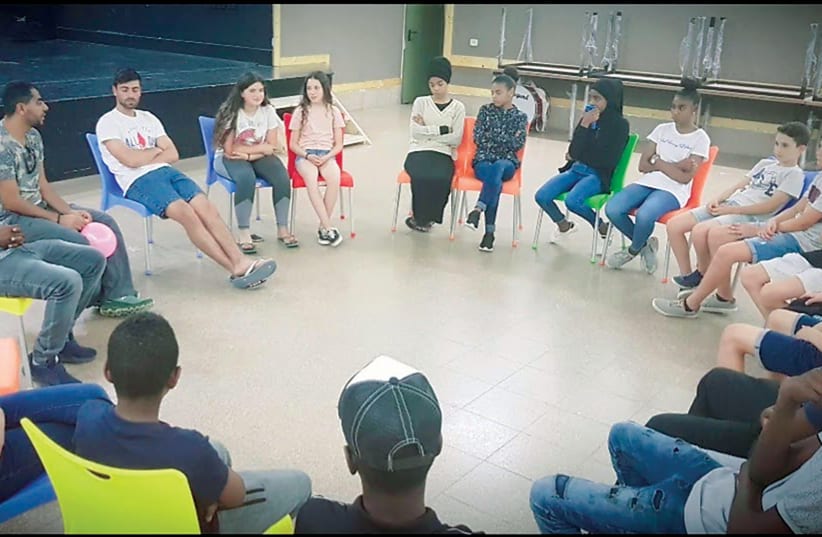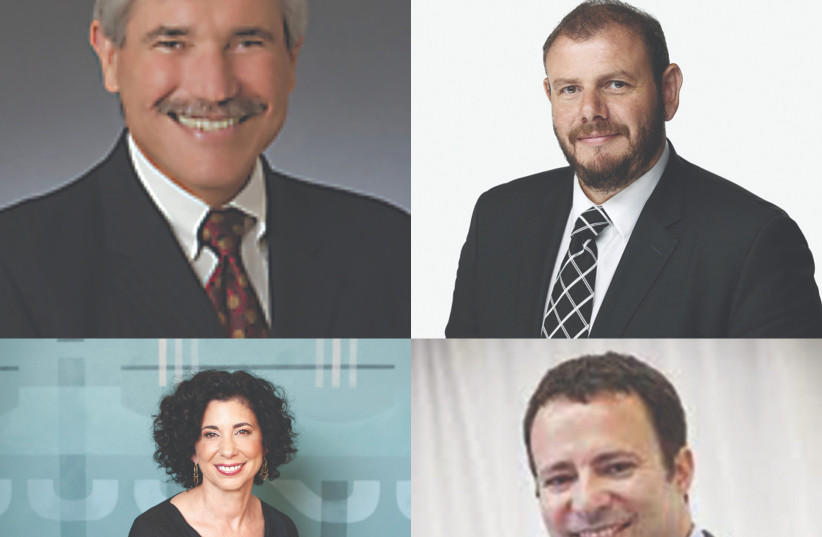Jewish teens from kibbutzim in the Bnei Shimon Regional Council in the northern Negev traveled just minutes away to the Bedouin city of Rahat for five icebreaking meetings with kids their age who they never would have otherwise met.
They toured the Bedouin market, engaged in workshops, played soccer, learned about each other’s cultures and prepared the dessert kadaif together. At first, most of the children were afraid to even speak to each other, but by the end, they were exchanging telephone numbers and inviting each other to their homes.
“It was very emotional,” said Liat Armerman, southern district community activities manager for the Social Affairs and Social Services Ministry. “It was interesting to see how simple it was. We just brought them together, and they did what they always like to do, but together.”
The children participating in the coexistence project had no idea that it was envisioned, initiated and funded in part by four North American Jewish communities. They also were unaware that their small project was actually part of one of Israel’s largest civil endeavors ever.
Over the next few years, Israel will be transferring as many as 35,000 soldiers from the overcrowded center of the country to new bases in the underpopulated south, including 7,000 career soldiers, most of whom deal with technological issues and have advanced degrees.
IDF units dealing with digital communications, computers and cyber technology will move to the Negev by 2024. Intelligence units will join them by 2026, bringing in an unprecedented amount of brainpower in a very short time to a region that has been socially, geographically and demographically disadvantaged since the founding of the state.
The Israeli government intends to take advantage of that influx to revitalize the Negev. To that end, a combination of five government ministries and several local authorities just allocated nearly NIS 500 million for this year alone to create an innovation district near Ben-Gurion University of the Negev and other civil infrastructure projects.
“This relocation is one of the most complex projects ever in Israel because career soldiers need communities, schools and culture for their families,” said Yonat Marton, head of civil infrastructure in the Defense Ministry. “We aren’t making a desert bloom, because it’s already far from being a desert. It has a university and hi-tech. We are taking a place with its own story and moving it forward significantly.”
To facilitate such a grandiose project, Marton realized she should also take advantage of the Jewish Federations that have been running projects in Negev partner communities for decades: Montreal in Beersheba and Bnei Shimon, Miami in Yerucham, Philadelphia in Netivot and the nearby Sdot Negev Regional Council, and Greater MetroWest, New Jersey, in Arad, Ofakim and the Merhavim Regional Council. The four federations joined the Defense Ministry, other government offices and local authorities to create the Negev Now Network, an innovative new model for strategic philanthropic partnerships in Israel that will help maximize the benefit provided to residents of the Negev.
“It has been a strange but interesting shidduch,” Marton said of the Defense Ministry and North American Jews. “This groundbreaking project must use connections not seen as natural that are very significant. The federations know the communities in the Negev and what worked well in North America. Their weight is being felt, and the power of the connection is dramatic.”
The federations brought many visionary ideas that worked in their communities, including creative place-making, which is the use of arts and culture by diverse partners to strategically shape the physical and social character of a place, in order to spur economic development, promote enduring social change and improve the physical environment.
Another idea that came from the federations was to better utilize Ben-Gurion University to build up the Negev. The model came from the success of Drexel University in Philadelphia, and it is being implemented in part by Professor Nadav Davidovitch, an epidemiologist and public health physician, who heads the university’s school of public health.
“This is one of the most exciting processes I have taken part in,” Davidovitch said. “The idea is to see how to engage the university with the community we are living in, with children and the elderly, changing the space in which communities are living. It’s a great example of how the university can work with NGOs, municipalities and ministries in solid sustainable collaboration.”
For instance, Ben-Gurion University built a food lab, modeled after one at Drexel, which helps teach the community about nutrition, health, sustainability and cultural issues. It conducted food preservation projects in local schools, IDF bases and hospitals that throw away too much food.
“The idea is to work with institutions to engage with food as much more than for eating,” Davidovitch said. “We are working in neglected Jewish neighborhoods and disadvantaged Bedouin communities on solidarity, sustainability and reducing inequality, engaging with the populations and promoting a greater understanding of well-being.”
There have been smaller projects conducted to build community connections in development towns, including a community radio station in Netivot, podcasts in the Lehavim Regional Council, and a “video, sound and digital art experience” in Sderot.
Israel Budik, southern district manager of the Social Affairs and Social Services Ministry, said corona resulted in organizations that help the disadvantaged losing contributions while their problems multiplied. He said government officials and their overseas partners responded by thinking outside the box about how to help.
“Corona made people connect differently because they had no choice,” Budik said. “They couldn’t leave home but still wanted to interact. Also, our supporters abroad wanted to feel they are part of us, even though they couldn’t come, so they were involved in presenting ideas. It is not the money that matters but the brotherhood in bridging gaps in society, strengthening the periphery and helping people succeed who wouldn’t otherwise be given an opportunity.”
The Negev Now Network’s chairwoman, Michele Levin of Philadelphia, said the work of the coalition was critical for Israel’s future sustainability.
“Israel is in trouble if the Negev isn’t developed properly,” she said. “What the people [of the Negev] don’t realize is that we [North American Jewish leaders] have motivated the government to be a part of projects that are cutting edge and make a difference. We bring creative ideas that make the Negev a better place to live.”
Miami Jewish Federation President and CEO Jacob Solomon said receiving credit is not what mattered to him.
“If the sole benefit of having the consortium is that it attracts resources from the national government to go to scale, dayenu,” he said. “There is no one silver bullet that changes the future. We really think that investing in the Negev is investing in the future, and we’re happy to do it with great partners. There are a handful of us who enjoy doing this together and see the impact and wisdom of it, and we hope more will join us.”
Solomon said he believes providing the cultural accoutrements of life that the new Negev residents were used to before they moved southward will create pressure for positive change.
“Negev Now allows us to think of strategic development that we think will have a long-term impact on the future,” he said. “The infusion of that much social capital into the Negev presents a really unique opportunity. We think it’s probable that we can capitalize on that human asset and use it to catalyze change in the region.”
Montreal Federation CEO Yair Szlak said donors ask why there is still a need to contribute to Israel if it is a successful “Start-up Nation” with a large gross domestic product. He said he replies that in the Negev, the nation-building of Israel goes on.
The Negev is 60% of Israel but only nine percent of Israelis live there.
“Partnering with the other federations makes it more meaningful and impacts more of the Negev,” Szlak said. “We see this collaboration as our raison d’etre. Sometimes you need to be able to zoom out and deal with the Negev in general. This is a way to do something more bold for regional development.”
Metrowest Federation CEO Dov Ben-Shimon said the Negev Now Network was revolutionary, because it breaks the model of how federations have worked in Israel. He said such strategic cooperation enables a fivefold return on investments, demonstrates an even greater commitment to the Negev and allows much more to be accomplished.
But for the youth of Rahat and Bnei Shimon, what matters is that what is being invested in the civil infrastructure of the Negev as the IDF moves southward will enable them to live better lives.
“I see the importance for me, because I am raising children here,” Armerman said. “I hope we will continue to do what we have been doing because I really believe in it.” ■

